15 Best Trees for Las Vegas Landscapes
BY MELANIE JOSEPH | MAY 25TH, 2023 | LAS VEGAS, LAWN CARE, NEVADAIt’s pretty exciting to live in Las Vegas – a city renowned for its vibrant nightlife, entertaining casinos, and luxurious hotels. But beyond the bright lights and busy streets, Sin City is also home to a diverse and unique landscape. So if you want your property to have a beautiful garden, you must learn more about these 15 best trees for Las Vegas landscapes.
With Southern Nevada’s arid climate and desert conditions, finding trees that thrive in this environment can be challenging for most homeowners. However, with proper care and attention, creating a stunning landscape is possible even in a desert environment.
In this article, we’ll cover:
- 15 Best Trees for Las Vegas Landscapes
- What Makes a Tree Thrive in Las Vegas?
- FAQ About the Best Trees for Las Vegas Landscapes
15 Best Trees for Las Vegas Landscapes
The following trees can tolerate the city’s unique climate while also adding beauty and character to any yard:
1. African Sumac (Rhus lancea)
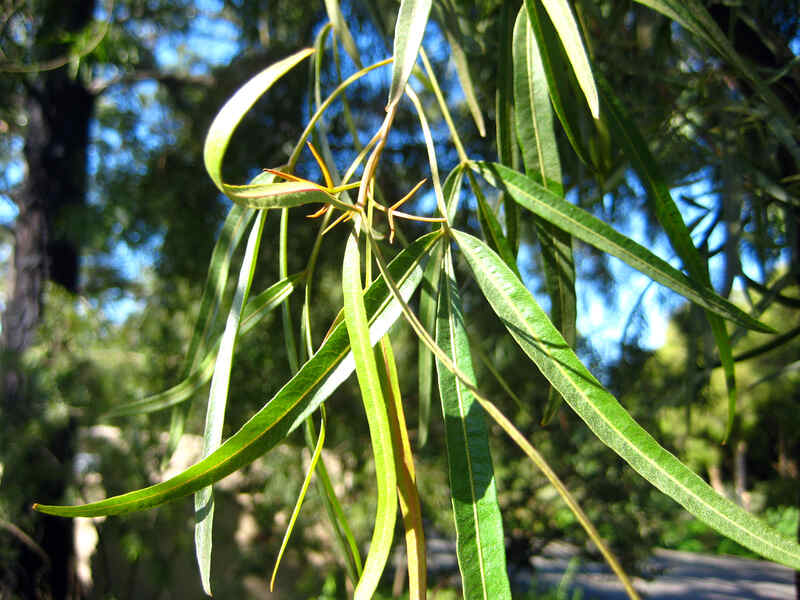
Photo Credit: Bri Weldon / Fllickr / CC BY 2.0
Native to southern Africa, this small tree has become a popular ornamental plant in Las Vegas. Homeowners love it for its dense, evergreen foliage and striking crown that add shade and visual interest to their gardens. In fact, you’ll often see these shade trees in parks, along streets, and in front yards throughout the city.
A perfect fit for the desert climate of Las Vegas, African sumac grows well in dry, semi-arid regions with rocky soil. Because of this, it’s already well-adapted to survive with little water, making it an excellent option for a low-maintenance garden. Apart from being heat and drought-tolerant, this desert tree also can withstand high winds.
If you want to use African sumac trees for your hedges and privacy screens, prune them regularly and remove dead or damaged branches to encourage healthy growth. Also, mulch around the base to improve soil quality and help retain moisture.
Growth habit: Small tree
USDA Hardiness Zone: 9-11
Mature size: 20-30 feet tall
Duration: Perennial
Foliage: Evergreen
Sunlight needs: Partial shade to full sun
Soil preferences: Well-drained, moist, alkaline, sandy, clay, or loamy soil
Water needs: Low
Potential hazards: Toxic – all parts of the tree are poisonous and can cause allergic reactions
2. Bay Laurel (Laurus nobilis)
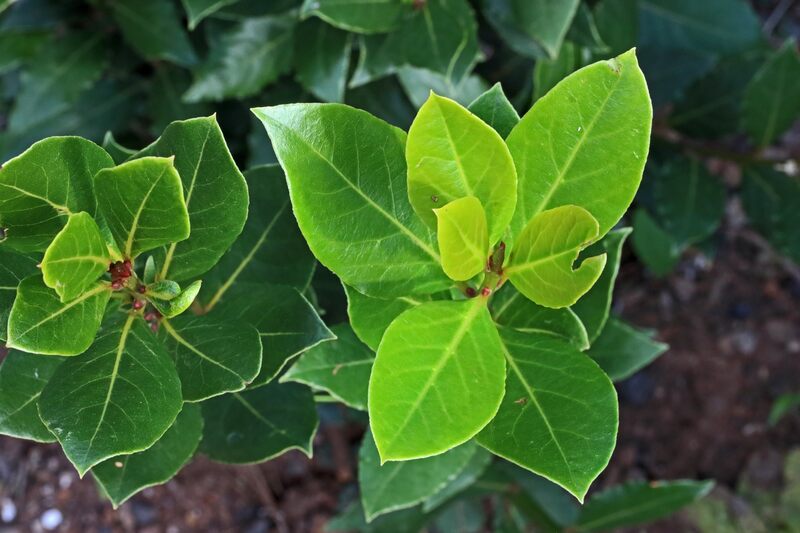
Photo Credit: Public Domain Pictures
Bay laurel has long been cultivated for its culinary and medicinal uses. Although native to the Mediterranean region, this drought-tolerant tree has found a home in many Las Vegas gardens due to its ability to thrive in varying climates. It can grow well even in rocky soil and dry and humid environments.
If you want to promote biodiversity and a healthy ecosystem in your garden, bay laurel is a wonderful option. It typically blooms in the spring, producing small, pale yellow flowers that attract bees and other pollinators. You can plant this evergreen tree in your Mediterranean-style landscape, patio, container garden, hedge, and privacy screen.
Growth habit: Shrub or small tree
USDA Hardiness Zone: 8-11
Mature size: 12-40 feet tall, 12-40 feet wide
Duration: Perennial
Foliage: Evergreen
Sunlight needs: Full sun to partial sun
Soil preferences: Well-drained, moist, rich, rocky soil
Water needs: Low to moderate
Potential hazards: Toxic to dogs, cats, and horses
3. Blue Palo Verde (Parkinsonia florida)
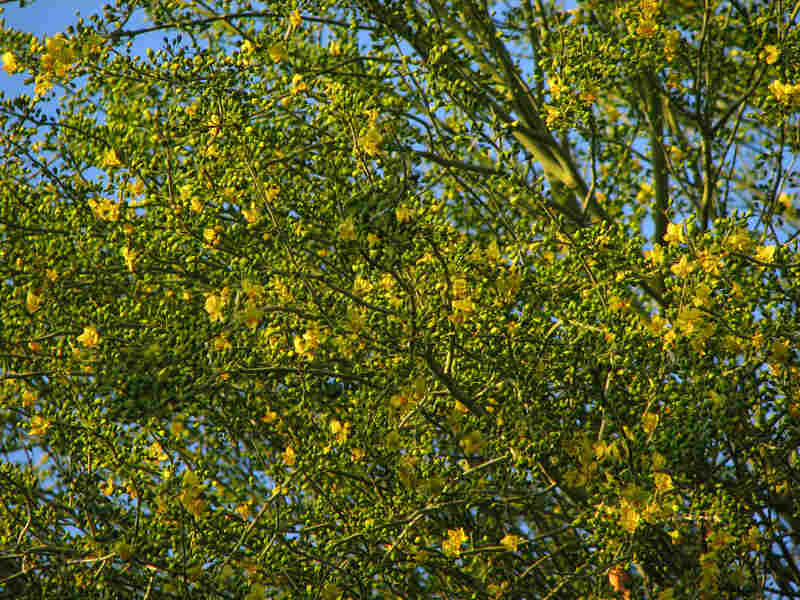
Photo Credit: Katja Schultz / Wikimedia Commons / CC BY-SA 3.0
An iconic tree native to the southwestern United States, including parts of Nevada, Arizona, and California, blue palo verde adds a touch of natural elegance to the urban environment. It grows in hot, dry regions – making it perfectly suited for the arid climate of Sin City.
With a distinctive greenish-blue bark and vibrant yellow flowers, this desert tree typically blooms in the spring and attracts various pollinators, including bees, butterflies, and hummingbirds. It’s a larval host to the palo verde beetle, a large insect often found around the tree in the summer.
To create a beautiful and cohesive landscape that celebrates the unique beauty of the desert, you can plant complementary species around this landscaping tree, such as desert marigolds or brittlebush. Also, pair it with one of the best grass types suitable for Nevada.
Growth habit: Tree
USDA Hardiness Zone: 8-11
Mature size: 20-25 feet tall, 15-20 feet wide
Duration: Perennial
Foliage: Deciduous
Sunlight needs: Full sun
Soil preferences: Well-drained, slightly alkaline, sandy, loam soil
Water needs: Low
Potential hazards: Non-toxic
4. Chaste Tree (Vitex agnus-castus)
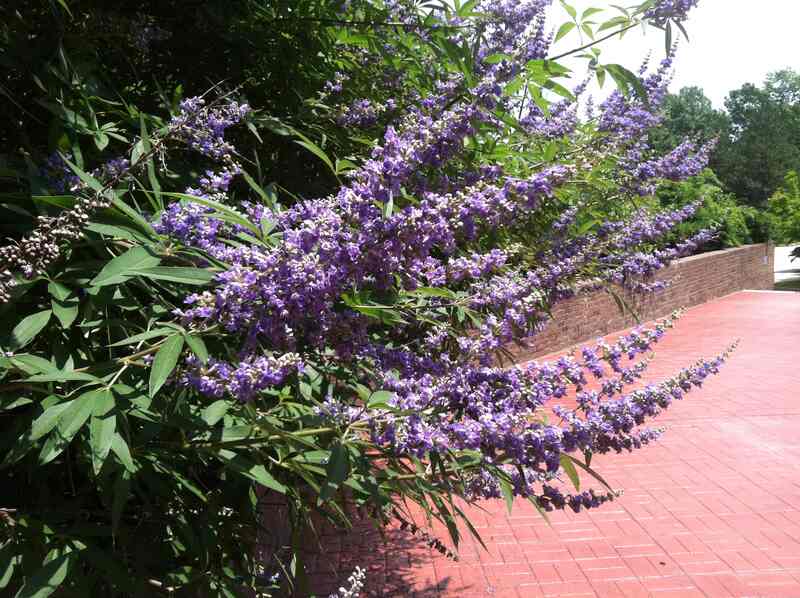
Photo Credit: MdAgDept / Flickr / CC BY 2.0
A beautiful and versatile plant, the chaste tree has already adapted well to the hot and dry climate of Las Vegas, Paradise, and Henderson. It blooms in the summer, and its showy spikes of purple or blue flowers attract hummingbirds, bees, and butterflies.
This fruit tree also produces small, dark purple to black fruits about the size of peppercorns. Also known as monk’s pepper, these chaste berries are used for medicinal purposes. Use them with caution, though, as they may cause side effects and interact with certain medications.
The chaste tree is often used as a drought-tolerant alternative to more traditional landscape plants. Also resistant to deer, this deciduous tree is perfect for cottage gardens, foundation plantings, garden beds, and borders.
Growth habit: Shrub or small tree
USDA Hardiness Zone: 6-9
Mature size: 4-15 feet tall, 4-12 feet wide
Duration: Perennial
Foliage: Deciduous
Sunlight needs: Full sun
Soil preferences: Well-drained but moist, loose, sandy, or loamy soil
Water needs: Low to moderate
Potential hazards: Non-toxic – but may cause stomach issues, nausea, itchy rashes, and diarrhea in some people
5. Crape Myrtle (Lagerstroemia indica)
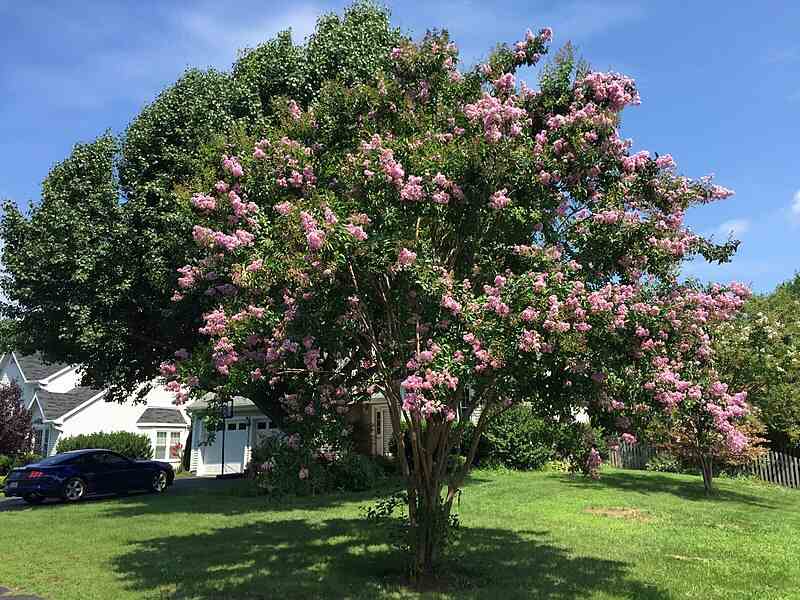
Photo Credit: Famartin / Wikimedia Commons / CC BY-SA 4.0
While crape myrtle can grow in various settings, including forests, savannas, and wetlands, it’s also well-suited for the desert environment of Southern Nevada. In Las Vegas, you’ll see it planted in residential landscapes, parks, and public spaces, including the Springs Preserve and the Clark County Government Center.
Known for its vibrant flowers, attractive bark, and drought tolerance, this deciduous tree has a long blooming season – typically from summer to fall. During this time, crape myrtle produces clusters of beautiful flowers in shades of pink, purple, red, and white.
Growth habit: Shrub or small tree
USDA Hardiness Zone: 6-9
Mature size: 6-12 feet tall
Duration: Perennial
Foliage: Deciduous
Sunlight needs: Prefers full sun
Soil preferences: Moist, well-drained, clay, loamy, sandy soil
Water needs: Low to moderate
Potential hazards: Non-toxic
6. Date Palm (Phoenix dactylifera)
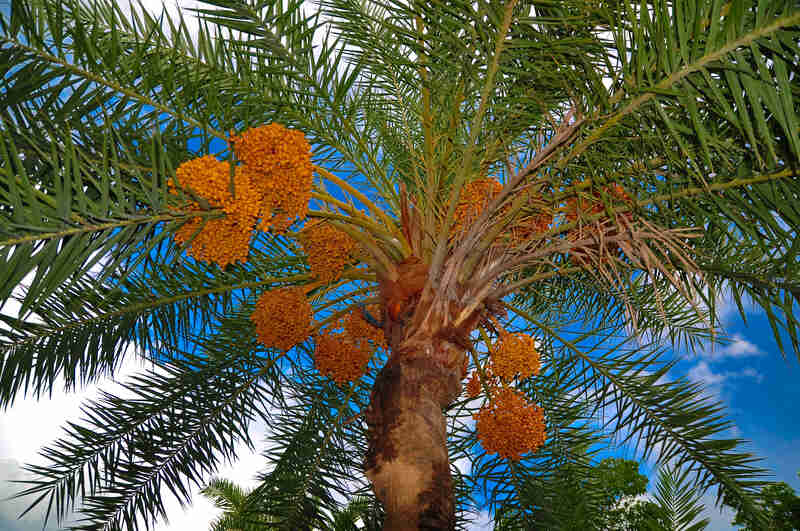
Photo Credit: Balaram Mahalder / Wikimedia Commons / CC BY-SA 3.0
The date palm is an iconic tree of the desert landscape that can be found throughout Sin City, including The Strip. This palm tree naturally thrives in hot, arid environments. With its tall, slender trunk and feather-like fronds, it’s not only a beautiful addition to any garden but also has a rich cultural and historical significance.
This hardy plant produces small flowers that bloom in early spring, which attract pollinators like bees and wasps. The female flowers then develop into the well-known date fruit – a staple food in many Middle Eastern cultures. The tree also can serve as a host plant for the Palm Weevil, a beetle species that lays its eggs in the tree’s trunk.
Regular pruning can help maintain the tree’s shape and prevent it from becoming too top-heavy. Additionally, providing the tree with adequate fertilizer can help promote healthy growth and enhance the size and quality of the fruit.
Growth habit: Palm tree or cycad
USDA Hardiness Zone: 9-11
Mature size: 50-80 feet tall
Duration: Perennial
Foliage: Evergreen
Sunlight needs: Full sun
Soil preferences: Well-drained, loamy, clay, chalk, or sandy soil
Water needs: Low
Potential hazards: Slightly toxic – its thorns are poisonous and may cause injuries
7. Desert Willow (Chilopsis linearis)
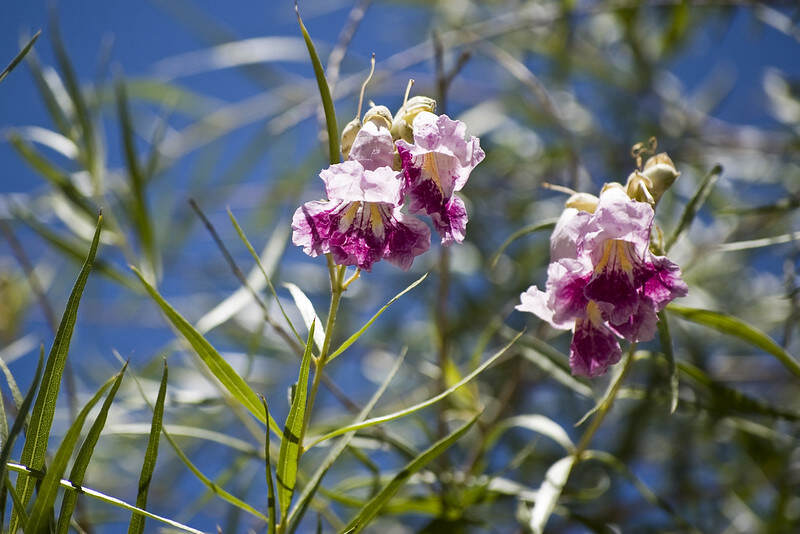
Photo Credit: Ken Bosma / Flickr / CC BY 2.0
A stunning flowering tree native to the southwestern United States, desert willow can thrive naturally in arid regions, including the Mojave Desert, Sonoran Desert, and Chihuahuan Desert. But in Las Vegas, this desert tree is often planted in many gardens and public spaces, including the Springs Preserve and the Nevada State Museum.
The desert willow blooms from late spring to early fall, producing fragrant pink or purple flowers that attract various pollinators. Its showy, trumpet-shaped flowers and graceful branches can add a touch of natural beauty to desert landscapes.
This heat and drought-tolerant tree is a symbol of endurance and strength, as it can survive in the harsh desert environment. And if you want to make it even more appealing in your garden, you can plant agave, yucca, and cactus around it.
Growth habit: Shrub or small tree
USDA Hardiness Zone: 7-11
Mature size: 15-30 feet tall, 10-20 feet wide
Duration: Perennial
Foliage: Deciduous
Sunlight needs: Prefers full sun
Soil preferences: Prefers well-drained soil but grows well in most soil types
Water needs: Low
Potential hazards: Non-toxic – but its bark can be poisonous to animals, especially cats
8. Honey Mesquite (Prosopis glandulosa)
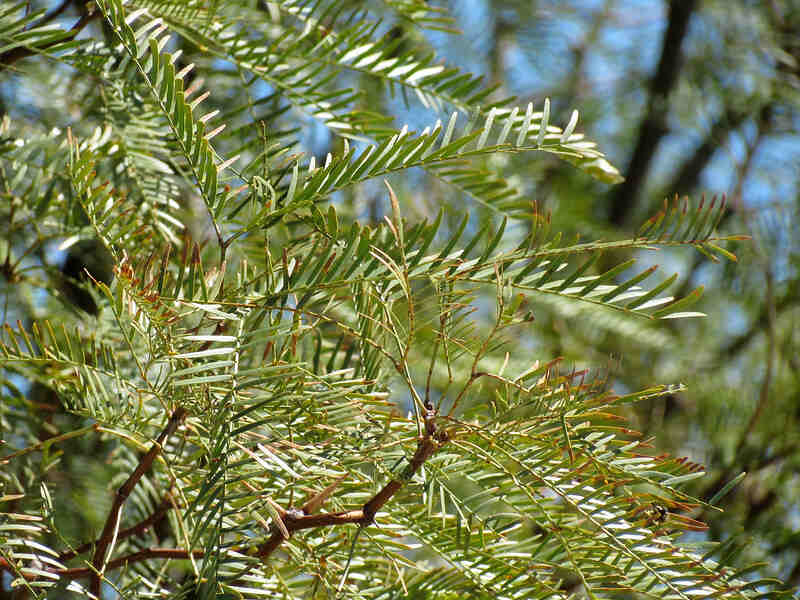
Photo Credit: Katja Schluz / Flickr / CC BY 2.0
With its drought-tolerant nature and ability to thrive in dry soil conditions, honey mesquite is a popular choice for landscaping in the Las Vegas Valley area. Smaller than the Chilean mesquite, this shade tree is native to the southwestern US and Mexico.
The honey mesquite is a vital food source for many desert animals, including birds, insects, and mammals. Its sweet-smelling flowers bloom in the spring and attract pollinators like bees and butterflies. It’s also a larval host for various butterfly species, such as the Reakirt’s blue butterfly and long-tailed skipper.
One important thing to consider is that honey mesquite has long, sharp thorns, so it can be hazardous to people and pets. As such, it may be best to plant it in areas where it will not pose a danger to those around it.
Growth habit: Shrub or small tree
USDA Hardiness Zone: 7-9
Mature size: 20-30 feet tall, 25-30 feet wide
Duration: Perennial
Foliage: Deciduous
Sunlight needs: Prefers full sun
Soil preferences: Grows in most soil types but prefers well-drained soil
Water needs: Low – doesn’t need supplemental watering once established
Potential hazards: Can be toxic to animals if consumed in large amounts
9. Joshua Tree (Yucca brevifolia)
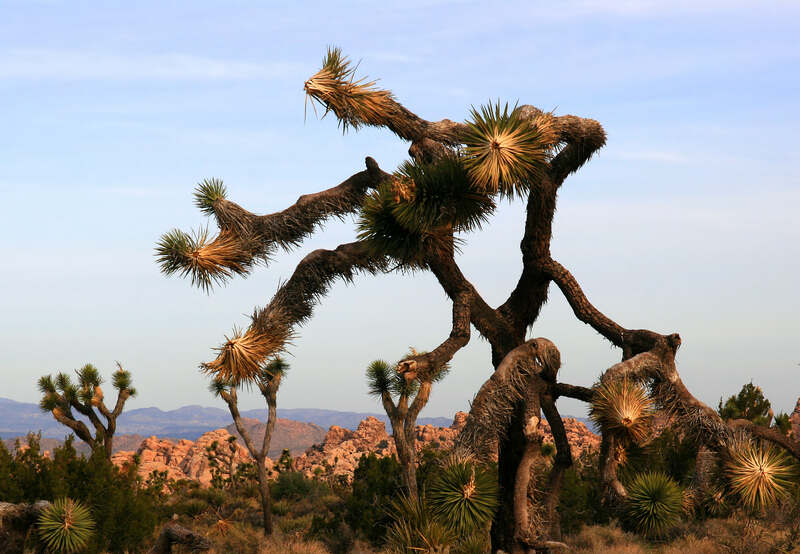
Photo Credit: Brocken Inaglory / Wikimedia Commons / CC BY-SA 3.0
With its unique branching pattern resembling outstretched arms, the Joshua tree is easy to spot in open, arid areas where this desert plant naturally grows. Known for its striking appearance and cultural significance, it’s an iconic symbol of the Mojave Desert and the American Southwest.
This slow-growing desert tree blooms from March through May, producing large white or greenish-yellow flowers with diameters of up to 4 inches. These flowers are pollinated by the yucca moth, which lays its eggs in the flowers, and the resulting larvae feed on the developing seeds.
Try incorporating native plants and natural landscaping techniques that require less water and maintenance. This way, you can create a natural-looking garden that reflects the beauty of the Mojave Desert while helping conserve resources. For example, you can use rocks and gravel as groundcover and select drought-tolerant plants like yucca, agave, and prickly pear cactus.
Growth habit: Tree
USDA Hardiness Zone: 6-10
Mature size: 15-30 feet tall
Duration: Perennial
Foliage: Evergreen
Sunlight needs: Full sun
Soil preferences: Dry, well-drained, coarse soil
Water needs: Low
Potential hazards: Toxic – can be severely poisonous
10. Oleander Tree (Nerium oleander)
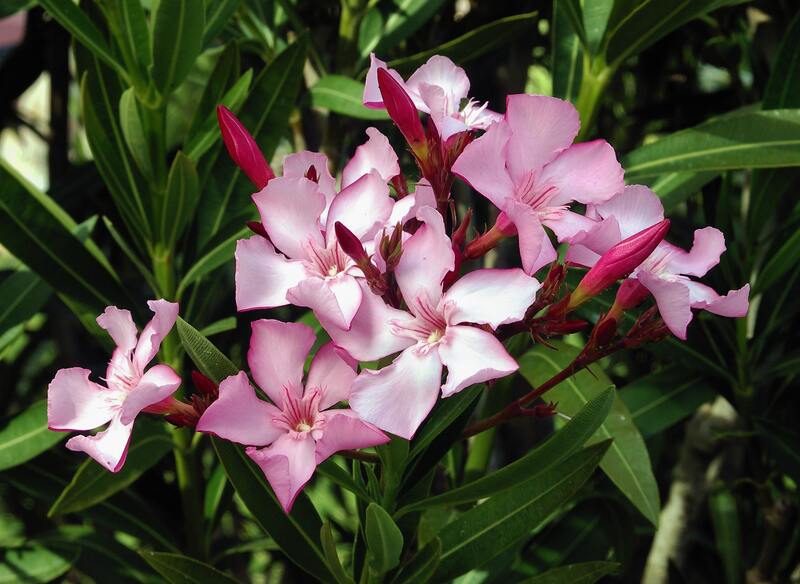
Photo Credit: Alvesgaspar / Wikimedia Commons / CC BY-SA 3.0
With its ability to thrive in hot, dry conditions, the oleander tree is perfect for adding beauty to pathways, wall-side borders, hedges, and privacy screens. From late spring through early fall, this evergreen tree produces clusters of showy, fragrant flowers in shades of yellow, red, pink, and white.
Although this versatile plant is native to the Mediterranean region and Asia, it’s well adapted to the Las Vegas desert environment. It can tolerate drought and resist deer and rabbits. But this fast-growing plant may need more frequent pruning than other plants in your garden.
Oleander is a larval host to the oleander hawk moth, found in parts of the Southwest, including Nevada. This moth lays its eggs on the leaves of the oleander tree, and the resulting caterpillars feed on the leaves before pupating and eventually emerging as adult moths.
Growth habit: Shrub or small tree
USDA Hardiness Zone: 7-12
Mature size: 6-15 feet tall, 6-10 feet wide
Duration: Perennial – but only in 8 to 11 USDA hardiness zones
Foliage: Evergreen
Sunlight needs: Full sun
Soil preferences: Prefers moist, well-drained soil but can grow even in poor soils
Water needs: Low to moderate
Potential hazards: Highly toxic
11. Southern Live Oak (Quercus virginiana)
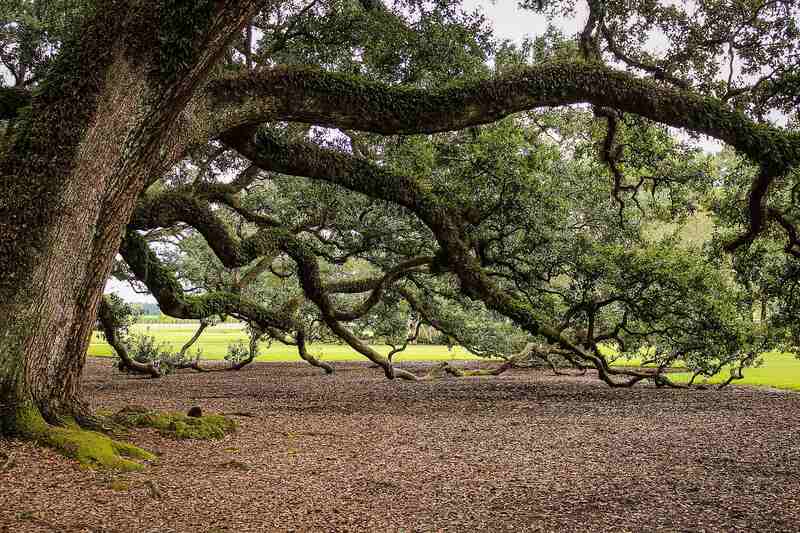
Photo Credit: Pixabay
Prized for their grandeur and shade-providing canopies, southern live oaks do well in Las Vegas’ hot, dry climate – provided they receive proper care. This majestic tree is a perfect specimen plant that can tolerate drought.
While southern live oaks do not produce showy flowers, they are an essential habitat for various wildlife, including birds, squirrels, and even certain species of bats. The tree’s acorns also serve as a vital food source for many animals.
If you want to maintain the shape and structure of your southern live oak, be sure to prune it regularly. Remember to avoid planting anything too close to its root system, as it can harm the tree’s health.
Growth habit: Tree
USDA Hardiness Zone: 8a-10b
Mature size: 40-80 feet tall, 30-100 feet wide
Duration: Perennial
Foliage: Evergreen
Sunlight needs: Full sun to partial shade
Soil preferences: Prefers well-drained, moist, loamy, or clay soil but can grow even in dry soil
Water needs: Low
Potential hazards: Toxic – avoid ingesting the acorns and leaves as they can be poisonous to both humans and animals
12. Southern Magnolia (Magnolia grandiflora)
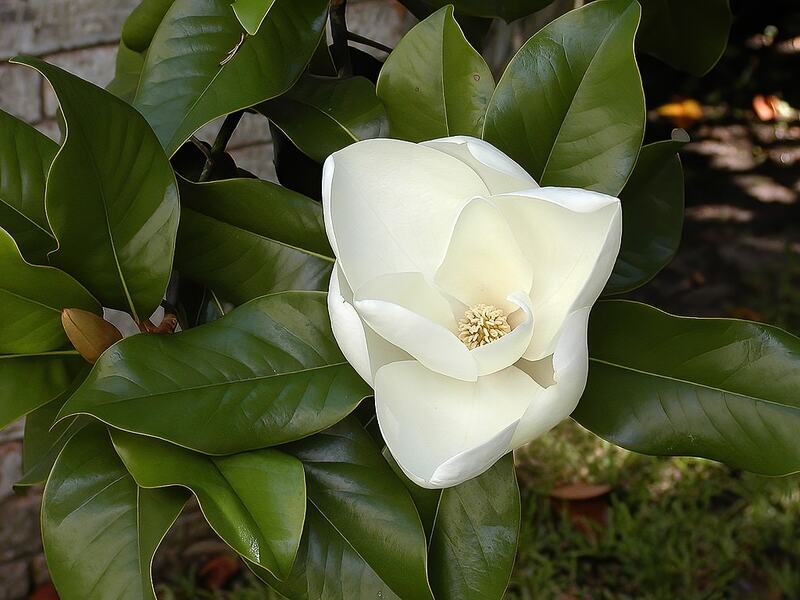
Photo Credit: Jim Evans / Wikimedia Commons / CC BY-SA 4.0
Another iconic tree species, the southern magnolia can grow up to 80 feet tall. But it is more commonly seen in Las Vegas at a smaller size. Still, with its beautiful, fragrant blooms and glossy, dark green leaves, it’s a standout feature that can add value to any garden in Sin City.
Typically blooming in the late spring to early summer, southern magnolia produces large, showy white or pinkish flowers that can be up to 12 inches in diameter. The flowers are often fragrant and attract various pollinators, including bees, butterflies, and hummingbirds. The tree is also a larval host to the Eastern tiger swallowtail butterfly.
Growth habit: Tree
USDA Hardiness Zone: 6-10
Mature size: 60-80 feet tall and 30-50 feet wide
Duration: Perennial
Foliage: Evergreen
Sunlight needs: Partial shade to full sun
Soil preferences: Well-drained, moist, fertile soil
Water needs: Low – may need supplemental watering during extended dry spells
Potential hazards: Non-toxic to both humans and animals
13. Sweet Acacia (Vachellia farnesiana)
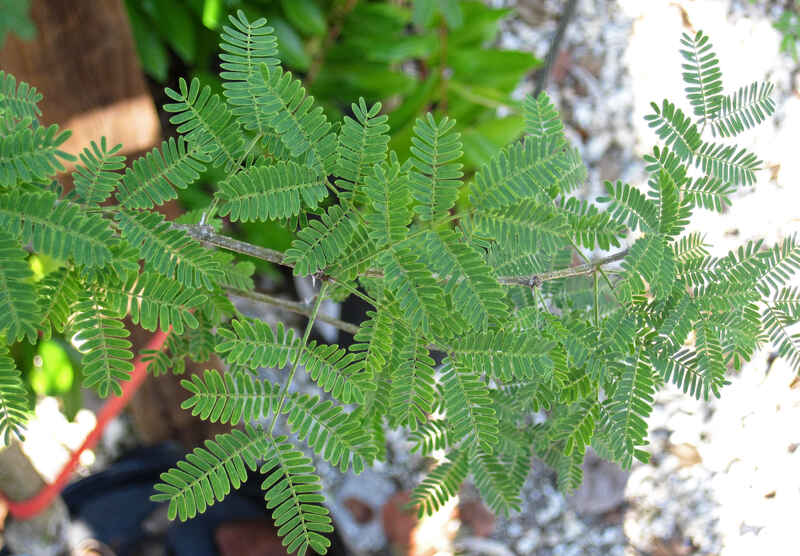
Photo Credit: James St. James / Flickr / CC BY 2.0
A drought-tolerant, flowering tree, sweet acacia is well-suited to the hot and dry climate of the Las Vegas Valley. Its natural habitat includes the southwestern U.S., as well as the Chihuahuan and Sonoran deserts of Mexico. From late winter through early summer, this small tree produces fragrant, golden-yellow blooms that attract bees, butterflies, and hummingbirds.
With its unique, fern-like foliage that’s evergreen in mild winter areas, sweet acacia can be an attractive feature in your landscape year-round. But remember to prune it to promote a strong, multi-stemmed structure and shape it to maintain a tidy appearance.
Growth habit: Shrub or small tree
USDA Hardiness Zone: 9-11
Mature size: 15-20 feet tall
Duration: Perennial
Foliage: Semi-evergreen to evergreen
Sunlight needs: Partial shade to full sun
Soil preferences: Moist to dry, well-drained, loose, sandy, or loamy soil
Water needs: Low to moderate
Potential hazards: Non-toxic to humans, but its seeds can be toxic to dogs
14. Texas Olive (Cordia boissieri)
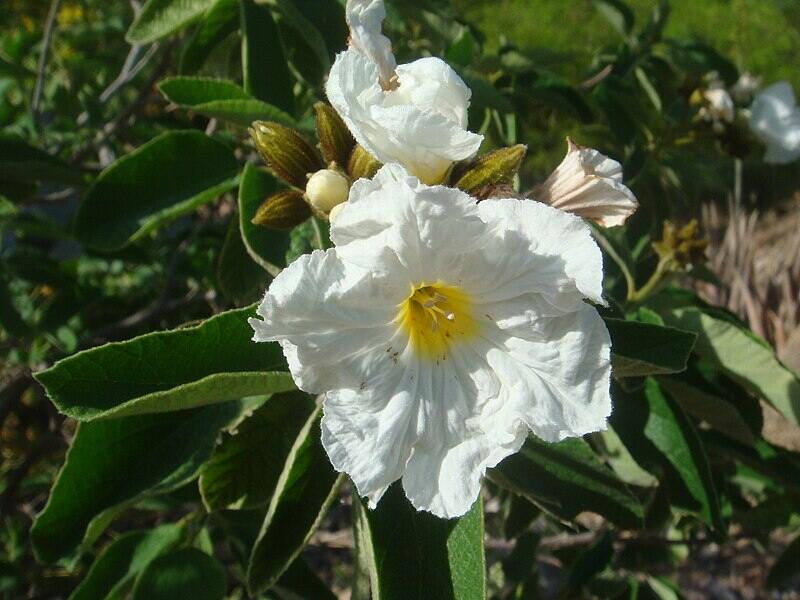
Photo Credit: Miwasatoshi / Wikimedia Commons / CC BY-SA 3.0
A small, multi-trunked tree native to Texas and Mexico, the Texas olive tree is prized for its delicate and fragrant white flowers. It blooms in the spring, followed by small, edible fruits that ripen in the summer. This evergreen tree is often used in desert landscaping designs, as its spreading canopy provides dappled shade.
Although it naturally grows in dry and rocky soils, Texas olive also can thrive in well-drained soils with minimal watering, making it a suitable option for Las Vegas homeowners looking for a drought-tolerant tree. And if you want to bring it indoors in the winter, you can plant it in a container.
Growth habit: Shrub or tree
USDA Hardiness Zone: 9-11
Mature size: 15-30 feet tall, 10-20 feet wide
Duration: Perennial
Foliage: Evergreen to semi-evergreen
Sunlight needs: Full sun to partial shade
Soil preferences: Prefers dry, well-drained, slightly alkaline soil but can thrive even in rocky soils
Water needs: Low to moderate
Potential hazards: Mildly toxic – its raw fruits can be slightly poisonous
15. Western Redbud (Cercis occidentalis)
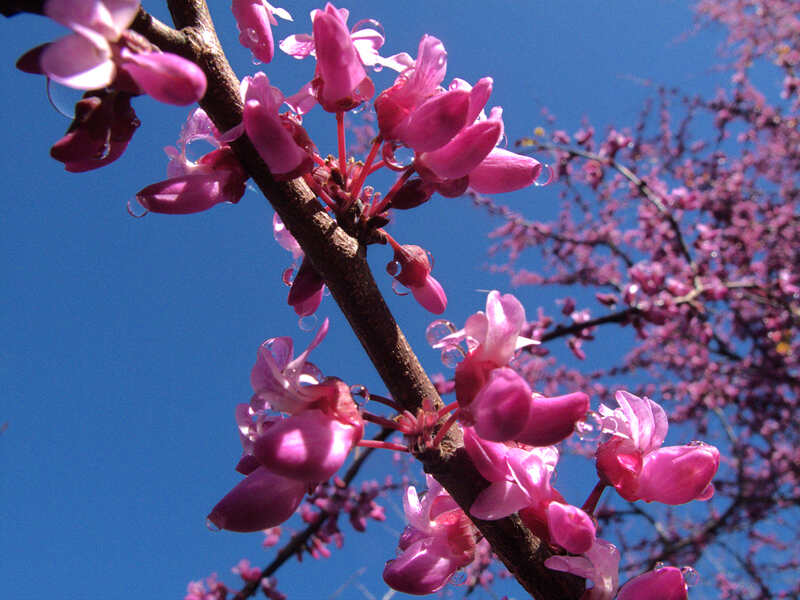
Photo Credit: John Rusk / Flickr / CC BY 2.0
In its natural habitat, Western redbud is found in the foothills and canyons of the western United States, from California to Utah. It thrives in dry, rocky soil and often grows alongside other desert plants like Joshua trees and creosote bushes. It has beautiful, heart-shaped leaves and can tolerate drought and resist deer.
This popular ornamental plant can be found in many residential landscapes and public parks throughout Las Vegas, including Floyd Lamb Park and the nearby Red Rock Canyon National Conservation Area. The tree blooms clusters of pink or purple flowers in late winter or early spring, providing an essential source of nectar and pollen for native bees and butterflies.
Growth habit: Shrub or small tree
USDA Hardiness Zone: 6-9
Mature size: 10-15 feet tall, 10-15 feet wide
Duration: Perennial
Foliage: Deciduous
Sunlight needs: Partial shade to full sun
Soil preferences: Well-drained, clay, chalk, sand, or loamy soil
Water needs: Low
Potential hazards: Non-toxic – its young pods and flowers are edible
What Makes a Tree Thrive in Las Vegas?
With its hot and arid climate, Las Vegas can be a challenging environment for planting and growing trees. However, certain species have adapted well and can thrive with the right care and attention.
Las Vegas is located in USDA hardiness zone 9a, which means its average minimum winter temperature is around 20 to 25 degrees Fahrenheit.
The city’s average high temperatures fall within this range:
- October to May: mid-60s to the mid-90s Fahrenheit
- June to September: mid-90s to over 100 degrees Fahrenheit
On the other hand, the average low temperatures in Sin City fall between:
- October to May: mid-30s to the mid-60s Fahrenheit
- June to September: mid-70s to the low 80s Fahrenheit
One key factor that determines a tree’s success in this climate is its water needs. Since Las Vegas is located in the desert, it receives very little rainfall. The average annual rainfall is only about 4.5 inches, with a large percentage falling during winter.
Trees native to the Southwest, as well as the ones listed above, thrive in Las Vegas because of their ability to:
- Tolerate drought and survive on very little water
- Thrive even in the intense heat of the desert
- Withstand extreme temperature fluctuations
- Resist high winds and gusty conditions
- Survive even in poor soil conditions
FAQ About the Best Trees for Las Vegas Landscapes
The first place you can try is the Springs Preserve – a 180-acre cultural institution showcasing the natural history of the Mojave Desert. Here, you can stroll through the botanical garden and see a wide range of trees and other desert plants.
Another great spot is the Red Rock Canyon National Conservation Area, just a short drive west of the city. Here, you can explore the stunning red rock formations and take photos of various desert trees, including the iconic Joshua tree.
If you want a more educational experience, the University of Nevada, Las Vegas (UNLV) has a campus arboretum featuring numerous trees and plants, including many desert-adapted species.
No. Under the Las Vegas Valley Water District (LVVWD) guidelines, watering is allowed at certain hours and days per week for each address, with designated days based on your watering group. However, watering is strictly prohibited on Sundays, regardless of address.
When choosing the best grass type for your Las Vegas landscape, you should consider the city’s hot and dry climate. The most popular grass type for this area is bermudagrass, which is known for its drought tolerance and ability to thrive in full sun. This warm-season grass requires regular mowing and watering during the growing season but can withstand hot summer temperatures and cold winters once established.
But remember that Nevada passed a law banning non-functional grass in certain areas, including the Las Vegas Valley. So, homeowners and businesses are required to replace non-functional grass with water-efficient landscaping or hardscaping. Non-functional grass refers to purely ornamental turf with no practical purpose, such as grass in medians or large lawns that are rarely used. This law aims to conserve water and promote sustainable landscaping practices in the region.
Plant the Right Trees in Your Las Vegas Garden
With the right care and attention, these 15 trees can thrive in your Las Vegas landscape. Not only can they withstand the heat, drought, and wind that are common in the area, but they also have stunning visual appeal and ecological benefits.
Whether you’re looking to plant a tree that provides shade, attracts wildlife, or simply adds a touch of greenery to your yard, there’s an option here to meet your needs. But remember to choose the right tree for your specific environment and soil type.
If you need help with your desert landscaping design, reach out to a local landscaping pro for expert guidance.
Main Image Credit: Oleander Tree / Pixabay